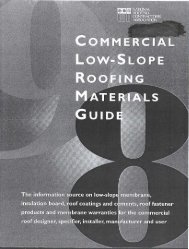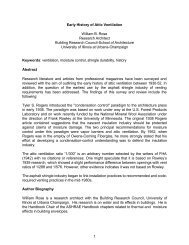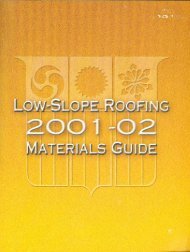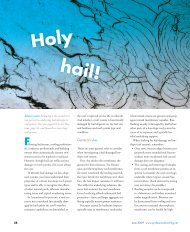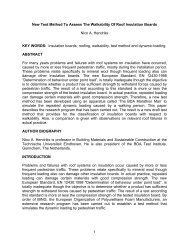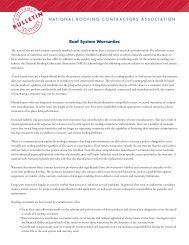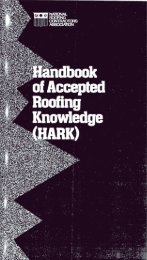! j I I - National Roofing Contractors Association
! j I I - National Roofing Contractors Association
! j I I - National Roofing Contractors Association
- No tags were found...
Create successful ePaper yourself
Turn your PDF publications into a flip-book with our unique Google optimized e-Paper software.
IInformation on Roof Board InsulationIROOF BOARD INSULATIONNRCA <strong>Roofing</strong> and Waterproofing Manual and the NRCA EnergyManual, available from the <strong>National</strong> <strong>Roofing</strong> <strong>Contractors</strong>Rigid roof board insulation materials are manufactured from <strong>Association</strong>.a variety of base materials or chemical compounds and aretypically categorized as either "homogeneous" or "composite"construction.MATERIAL STANDARDSFor purposes of the listings contained in the Guide, the followingdefinitions ?nd generic classes are used:Several material standards have been de\.eloped for insula-H I I t. B rd tion board materials. These standards define a variety of physomogeneousnsu a Ing oa s . aI . h . I d d . th G ide d I.A " b . d fb d . I . d th h IC propertIes t at are not mc u e m e u pro uct 1stnyprela ncate roo oar msu atlon pro uct at as one . F t . fi t.. . mgs. or curren m orma Ion on these s tan dar ds or 0 therInsulatIon layer component manufactured from any one of t h . I d ta . t th " t th A . S . . ec nlca a ,wn e e manUlac urer, e merlcan ocle tyseveral base mate~als. Top and/or .bottom surfaces may ~r may for Testing and Materials (ASTM), 1916 Race Street, Philadelnotbe coated or Impregnated wIth asphalt or other bInders phl.a P'A 19103 th S .-', d ' th " .aI h fi il ' fi I ,no, or e upenn ten den t 0 f Documen ts, US ..anwor covere WI Lacer maten s, suc as 0 s, orgamc e ts, Government Printing Office, Washington, DC 20402.glass fibers, and kraft paper.Generic ClassesA. Expanded polystyrene MATERIAL (PRODUCT) DESCRIPTIONSB. Extruded polystyreneC. Glass fiber/mineral fiberD. Cellular glassExpanded Polystyrene (EPS)Expanded (molded) EPS board is formed from a plastic (poly-E. Phenolic styrene) polymer, which is supplied by several companies toE Fiberboardregional converters. The process includes molding into blocks,G. Perlite processing into sheets, and applying facer materials (optional).H. Polyisocyanurate The converted materials generally conforms to materialI. Other homogeneous materials specifications published by the Society of the Plastics Indus-. " try (SPI). Some of these specifications with other calculatedComposite .Insulatlng Board~ . data; are shown in the following EPS Material Data Sheet, and~ny prefab~lcated roof board InsulatIon. prod~ct that con. may be used in conjunction with the individual product list-SISts ?f muluple (more than o~e) laye~ of msul~uon(s) and/or ings shown in the EPS section.a varIety of other board materIals (typIcally perlIte, fiberboard, The following "Usage Notes" 'for expanded EPS material~Iywood, and gypsum board) to form a unwed bonded mul- is reprinted from the Society of the Plastics Industry "Root:tllayer component. Top and/or bottom surfaces mayor may ing Design Ideas" brochure. .not be coated or impregnated with asphalt or other bindersFlammability Like many construction materials, EPS is com-bustible. It should not be exposed to flame or other ignitionsources. Current model building code requirements shouldbe met for adequate protection or separation from occupiedand/or covered with facer materials such as foils, organic felts,glass fibers, and kraft paper.SELECTION CRITERIA. ..,.The se!ecuo~ o~ the aPr.rop.rlate roof l~sulatlon maten~s forSolvent attack EPS is subject to attack by petroleum-based ."~solvents and coal tar products. Care should be taken to pre. ~~a. specIfic b~lldm~ appllCatlOll shou!d !nvolve the. conslderalIonof the msulatlon component wlthm the specIfic roofingvent contact between EPS, these materials, and their va ors.psystem. Some considerations are: compatibility with other roof Ultraviolet degradation Prolonged exposure to sunlight willsystem components, substrate, desired thermal barrier objec- cause a slight discoloration and surface dusting of EPS insutives,durability, resistance to climatic conditions, stability, in- lation. Though the insulating properties will not be signifistalledweight, method of attachment, fire and wind resistance, cantly affected unless exposure is so excessive that thicknesslife cycle costs, need for additional slope (drainage), warran- is lost. EPS should be covered to pre\.ent ultraviolet degradaties,and cost. In practice, no single commercial product tion if it is to be stored in the open for extended periods.posesses all of the ideal properties. Therefore, the designer I tall t " 1;" II ' h d f I. .... . ns a Ion exposure cO owIng eac ay 0 app Icatlon, allshould th choose . materIals wIth properties that are best suIted d f . I . h Id b d d .1fi . expose roo msu atlon s ou e covere an temporarl yto e speci IC project. aI d f . . d . se e rom moIsture m accor ance WIt h goo d roo fimgpractices.Insulation exposed to moisture should be replaced orTHERMAL VAWESthoroughly dried prior to application of roofing,areas.Application temperatures In roof construction requiringRoof board insulation materials are often rated and described hot asphalt, temperatures should not exceed 250 degrees Fin manufacturers' literature relative to heat transfer or at the time of direct application to insulation. Avoid contactresistance to heat flow. These properties are stated in terms between EPS and high-temperature equipment, such asof thermal conductance (k), thermal conductivity (C), ther- asphalt kettles and flame sealers.mal resistance (R), or overall coefficent of thermal transmission(U) for a complete ceiling-substrate-roof membrane con. Vapor re~ers, . .Each roofing applIcation should be st~dledstruction. An explanation of these terms can be found in the to determIne the need for a vapor retarder to control mter-. 364


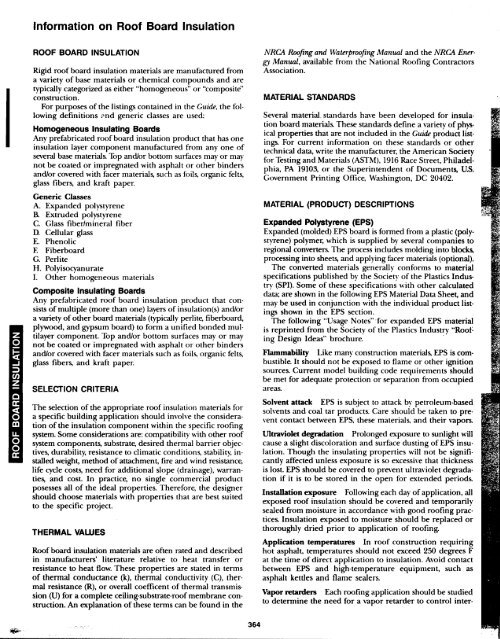

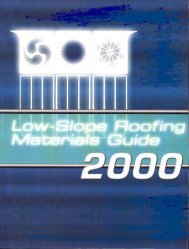
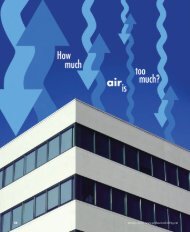

![Wm] - National Roofing Contractors Association](https://img.yumpu.com/36696816/1/190x245/wm-national-roofing-contractors-association.jpg?quality=85)

